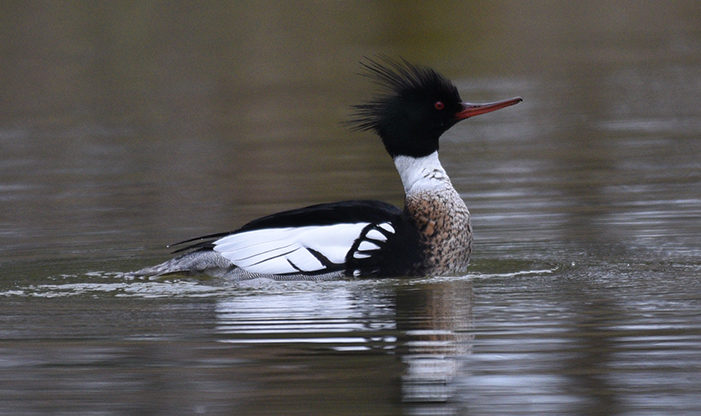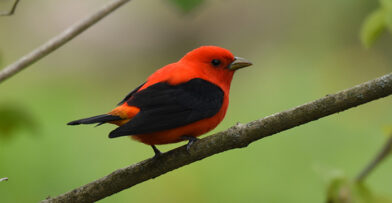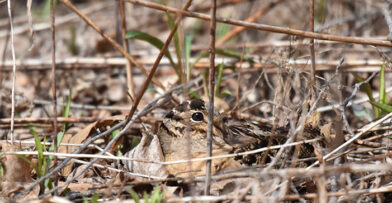Our Bird Profile series highlights a species that is migrating through, breeding, or is a year-round resident of Wisconsin that can be found at Schlitz Audubon or in your backyard.
Name
Red-breasted Merganser, Mergus serrator
Basic Description & Appearance
The Red-breasted Merganser measures 20-24 inches in length as an adult and has a 28–34-inch wingspan. The male and female are sexually dimorphic; the male has a reddish breast on a gray body, a white ring around its neck, a green head with a shaggy crest, and an orange bill. The female is mostly gray with a reddish head bearing the same shaggy crest. Both have a long, thin bill with a serrated edge used to catch and hold on to fish.
Vocalization
Generally silent, but when displaying, males make a cat-like meow sound while females make a raspy, croaking call.
Habitat & Nesting
This species forms mated pairs during spring migration. Groups of males will display for a single female. The male will engage in a head shake, or a salute curtsy, in which he dips his bill down, then flicks it up while his chest rises upward in the water.
Their breeding grounds include freshwater lakes, ponds, and rivers across Alaska and Canada in North America, into the Great Lakes and along the Atlantic Coast, as well is in Europe and Asia. They are ground nesters, compared to the cavity nesting Common Merganser, and make their nests on land near forested wetlands. Red-breasted Mergansers nest farther north than the Common Merganser and winter further south. When mated, females will lay eggs in their own, other species, and in other merganser nests, with broods averaging from 5-24 eggs. She will then nest and raise her brood on her own.
In North America, they are short- to medium-distance migrants, wintering in small flocks on the Great Lakes, near fresh and saltwater wetlands, and along both coasts as far south as northern Mexico and Florida. The Great Lakes are usually about half-covered by ice in winter, so the birds will spend time off the shore where they can forage for food.
Diet & Foraging
The Red-breasted Merganser is a diving duck (Mergus means diver), spending most of its time on the surface of a water body, deep diving to catch small fish but also eating crustaceans, aquatic insects, and frogs. They are adept on the water, and will go wherever there is prey, scanning from the surface and diving in search of prey. They are also known to dive in formation to herd schooling fish.
When & Where to Find at Schlitz Audubon
You can find them along the shores of Lake Michigan mostly from November through April, on the surface of the water near the shore. They are sometimes close enough to land that they can be seen without a spotting scope. On occasion, Red-breasted Mergansers have been seen at Mystery Lake.
Other Fun Facts
- Can stay beneath the water’s surface for almost a minute while foraging up to 20 feet deep.
- Need to forage up to 5 hours per day and eat 15-20 fish to meet their daily energy requirements.
- Among the fastest flying ducks, clocking speeds of up to 81 mph.


